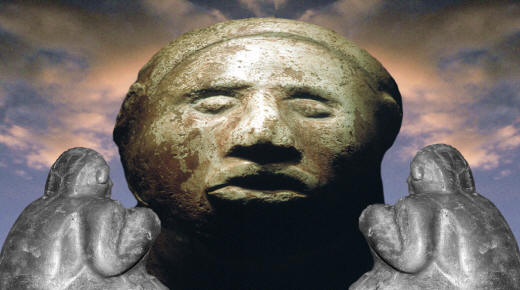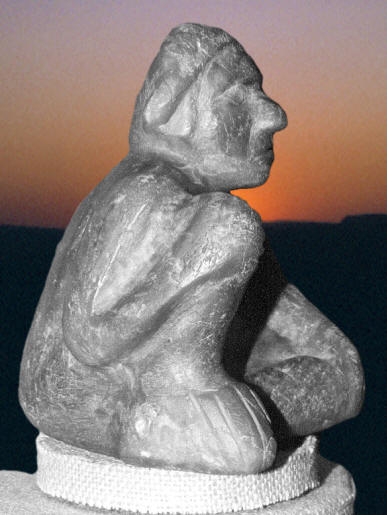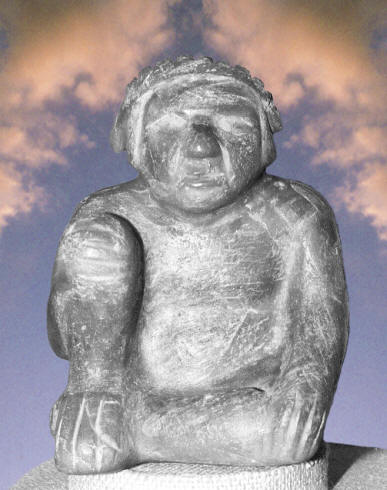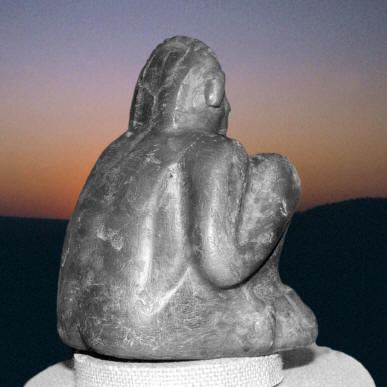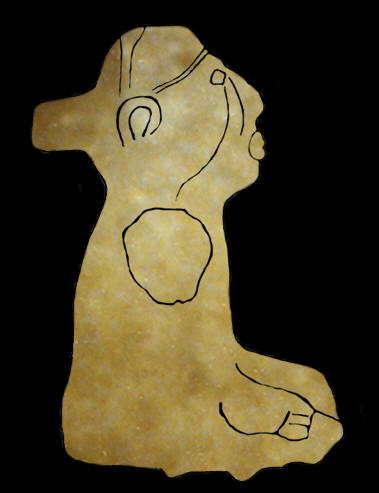|
|
|
The Angel site figure was found on November 26, 1940 by an archaeological excavating team, apparently under the direction of Dr. Glenn A. Black. His account of the discovery describes the find----"On November 26, 1940, the mound crew foreman sent word that something of interest had turned up.-----We were presently surprised, therefore, when we arrived at the spot to see that "something of interest" had indeed "turned up." In removing the .8 to 1.2-foot cut in Block 70R-2 one of the workmen, using a shovel, had noted that the shovelful of earth that he was in the act of removing cleaved away from something "shiny" that he thought was "glass." The foreman was called to the spot and recognized it for what it was--the head portion of a human figure of yellowish fluorite!" |
|
|
Both the Anna, Angel site and Cahokia fluorite figures were sculpted in the same seated posture. The figures represent adult males who are sitting with their right legs flexed up against the right side of the chest and with the right hand resting on the knee. The left leg is flexed horizontally so that the left foot is behind the right heel and the left hand is resting on the left knee. |
|
|
Other similarities between the two figures include the same design across the top of the head. There is a band or crenelated (notched) crest that spans from ear-to-ear on both figures. This design may either represent the style of the hair or some type of headdress. The back of both of the heads are also flat which may represent the practice of deforming the skull. Glenn Black writes that "Most of the male skulls found here have a flattened occipital (back part of the head)." Both figures also have well formed ears, eyes, noses and mouths. Glenn Black also mentions one peculiarity about the expression of the mouth of the Angel Mound figure. Because of a natural fault near the edge of one corner of the mouth, the expression can appear either jovial or with "complete seriousness," depending on the angle that it is viewed. |
|
|
The Anna and Angel site figures were found during the excavation of mounds. The discovery of the Johnston figure was found in a cultivated field. The find was described by E. E. Curtis---"In May of 1954 Willard Johnston was cultivating his corn, in a field owned by Mrs. Mildred Orange at the edge of the bottom land on the Ohio River several miles below Tolu, Kentucky, when the cultivator blade lurched to one side and brought a solid object to the surface. After making three trips around the field his curiosity had become sufficiently aroused so he stopped to investigate. Removing the dirt, he found it take form as he recognized the stone image of a man." The Johnston figure is made of fragile fluorite crystal and as would be expected for such a large object to be found in a cultivated field it was found damaged. Both arms were broken away. One of the arms was later found and restored to the statue. |
|
|
|
|
Like the Anna, Angel site and Cahokia figures the Johnston statue is also impressive for its size. The Johnston figure measures 10 inches high and weighs 18 pounds. It's carved features differs from the Anna and Angel site figures in several ways. The Johnston figure has a round projection extending out from the back of the head that represents a single hair bun, similar to the large marble male statue found at Etowah. Although one arm is missing, the Johnston figure's posture appears to be sitting with legs crossed and with both hands on each knee, also in the same way as the Etowah figure is sitting. The top of the head is described as having a "raised band across the top and a narrow band leading from two engraved circles in the center of the forehead to the ear as if the figure wears a decorated bandeau or tiara." |
|
| CONTINUE ON TO PAGE THREE | |
|
"REFERENCES"
1896,
Wilson, Thomas, Smithsonian Annual report,
"Prehistoric Art: Or The Origin Of Art As Manifested In The Works Of
Prehistoric Man," pp. 480-481. |
|
